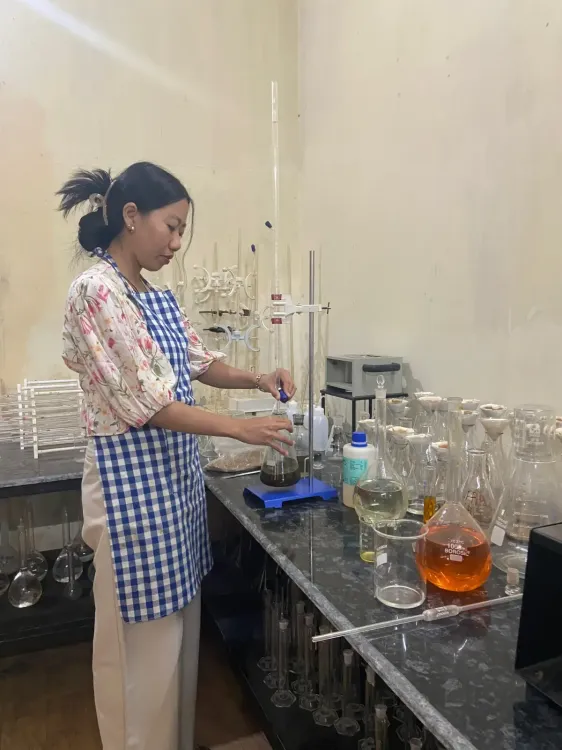What does the Nagaland University-led study reveal about rapid soil degradation in the Dhansiripar region?

Synopsis
Key Takeaways
- Rapid soil degradation is occurring in the Dhansiripar region due to diverse land-use practices.
- There is a pressing need for sustainable land management to protect agricultural productivity.
- The study involves multiple institutions, showcasing collaborative research efforts.
- Key soil metrics assessed include soil acidity, organic carbon, and nutrient availability.
- Findings aim to enhance local livelihoods and support policy development.
Kohima, Nov 24 (NationPress) A research team spearheaded by Nagaland University, the only central university in the state, has revealed alarming insights regarding the rapid degradation of soil in the Dhansiripar region. The extensive study highlights the detrimental effects of varied land-use practices on soil health, signaling an urgent call for sustainable land management to safeguard agricultural productivity and environmental integrity.
According to university officials, this research emphasizes the pressing need for effective land management strategies to enhance environmental stability and agricultural output.
The investigation covered soil analysis across six villages—Amaluma, Dhansirpar, Doyapur, Kiyeto, Melongmen, and Razhaphe—to understand the intricate relationships between local farming practices and soil attributes. Situated in Dimapur district of Nagaland, the Dhansiripar region is experiencing rapid soil degradation.
This study not only advances scientific knowledge but also carries significant societal implications, impacting local agricultural practices, aiding policy formulation, enhancing environmental conservation, and contributing to long-term food security.
The researchers aim to provide data-driven insights that empower farmers to boost crop yields, promote sustainable agriculture, improve local livelihoods, and align with national objectives for environmental resilience. They investigated how swift agricultural expansion, urbanization, and forest conversion are influencing vital soil characteristics, such as soil acidity (pH), bulk density, porosity, water retention, organic carbon, and nutrient availability.
Findings indicate that existing practices in the region contribute to soil degradation, reduced fertility, and increased erosion risks—concerns raised by farmers during initial field surveys. This research was conducted collaboratively by Nagaland University and experts from the ICAR-Indian Agricultural Statistics Research Institute, University of California, San Francisco, Dibrugarh University, Tocklai Tea Research Institute, and Diphu Medical College and Hospital.
The results were published in an international, peer-reviewed journal by the global publisher Springer, focusing on scientific methodologies, tools, and data for tracking environmental quality.
Prof. Jagadish K Patnaik, Vice Chancellor of Nagaland University, remarked, “Our findings from this multi-institutional study reveal that the Dhansiripar region is undergoing rapid soil degradation.”
He noted that the research team identified strongly acidic soils, declining structural integrity, and significant nutrient availability fluctuations across the six villages surveyed. The university advocates for the immediate implementation of sustainable land-management practices to avert further deterioration and protect the region’s agricultural viability and environmental health, as emphasized by Prof. Patnaik.
A key focus of this study was to analyze how soil properties vary among lowland paddy fields, cultivated agricultural areas, orchards, and forested regions. Advanced tools like multivariate analysis of variance, principal component analysis, and cluster analysis were employed to quantify variations and identify root causes.
Soil acidity levels were found to range from pH 4.9 to 5.9 across different sites, while organic carbon content varied between 0.45 and 3.69 percent, indicating significant differences in organic matter turnover. The research team also highlighted marked variations in macronutrient availability and cation exchange capacity, necessitating tailored nutrient management practices.
Co-author Prof. Manoj Dutta, from the Department of Soil and Water Conservation, School of Agricultural Sciences, Nagaland University, stated, “This study thoroughly investigates a wide range of land use systems, including lowland paddy fields, agricultural plots, thriving orchards, and lush forest areas.”
The comprehensive approach employed in this research allows for an in-depth understanding of how different land management practices influence soil properties, facilitating specific and insightful comparisons that are often overlooked in contemporary peer-reviewed studies.
Furthermore, Prof. Tanmoy Karak from the Department of Soil Science, School of Agricultural Sciences, stated, “Our findings indicate that soil in Dhansiripar is exceptionally susceptible to erosion and loss of fertility, with the Soil Structural Stability Index reflecting degradation in lowland paddy zones.” These results underscore the necessity for land-use-specific conservation strategies and sustainable agricultural practices.
“Our research also incorporates the views of local farmers, whose insights have significantly shaped the study’s long-term goals,” observed Prof. Karak.
PhD Scholar Reshinaro Tzudir from the Department of Soil and Water Conservation emphasized, “Our study highlights the considerable variability in soil properties across different regions and the alarming vulnerability of these soils to erosion and fertility loss under current agricultural practices.”
This situation raises urgent concerns about the sustainability of our ecosystems. She added, “By focusing on the extensive degradation observed in various areas, we stress the urgent need for innovative, sustainable management strategies. This focus aligns with growing global efforts to combat soil degradation and ensure the preservation of our natural resources for future generations.”
Dr. Ranjit Kumar Paul from the ICAR–Indian Agricultural Statistics Research Institute in New Delhi noted that the study employs advanced multivariate statistical techniques to provide a thorough quantitative analysis of soil characteristics.
“This rigorous methodological framework not only enhances the reliability of the results but also enables stronger conclusions regarding the relationships between land use and soil properties,” stated Dr. Paul.
The research is notable for its emphasis on a region that has largely been overlooked in terms of detailed soil health assessments. Its comparative analysis across various land-use systems, combined with robust statistical modeling, offers a comprehensive view of soil dynamics that is seldom available in the Northeast region.
Looking forward, the research team plans to conduct longitudinal studies to monitor changes in soil properties and implement practices such as agroforestry and improved crop rotations. They also aim to collaborate with local communities to integrate traditional knowledge.
Additionally, the researchers intend to engage policymakers to advocate for evidence-based land-use planning and to explore soil biological properties for a more complete understanding of soil health. They propose comparative studies with similar regions and community awareness initiatives as part of their future roadmap.









